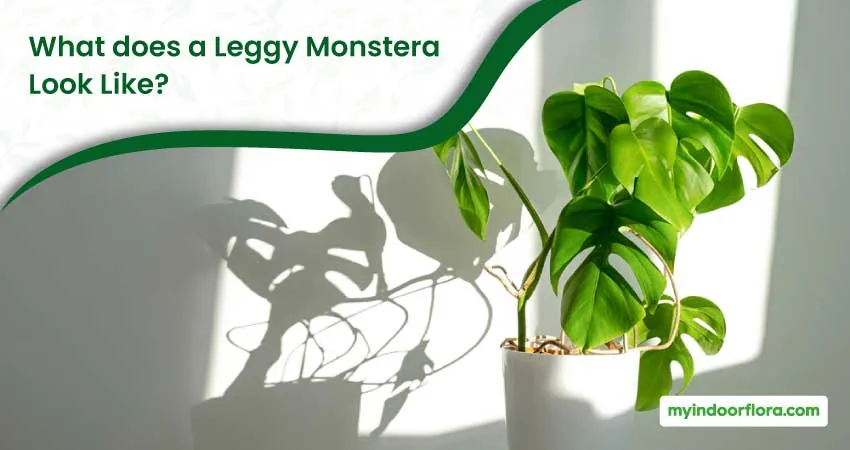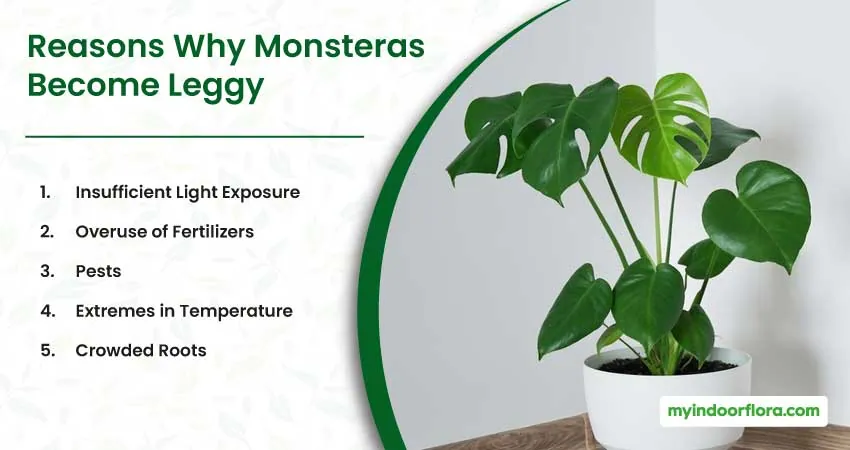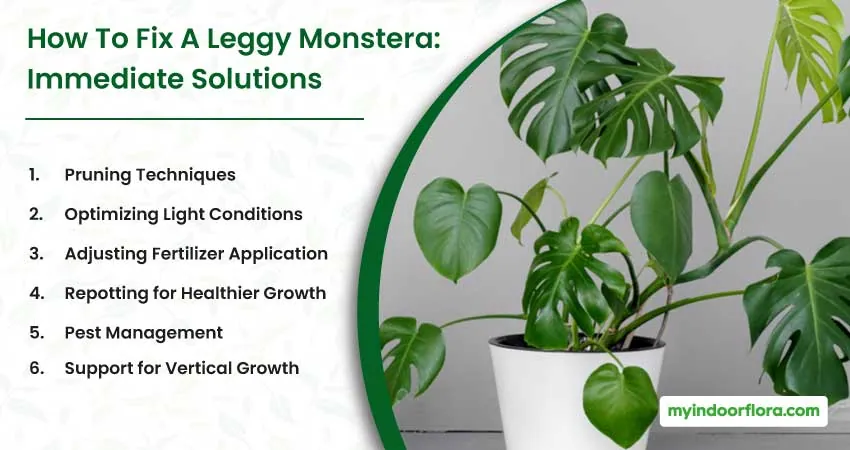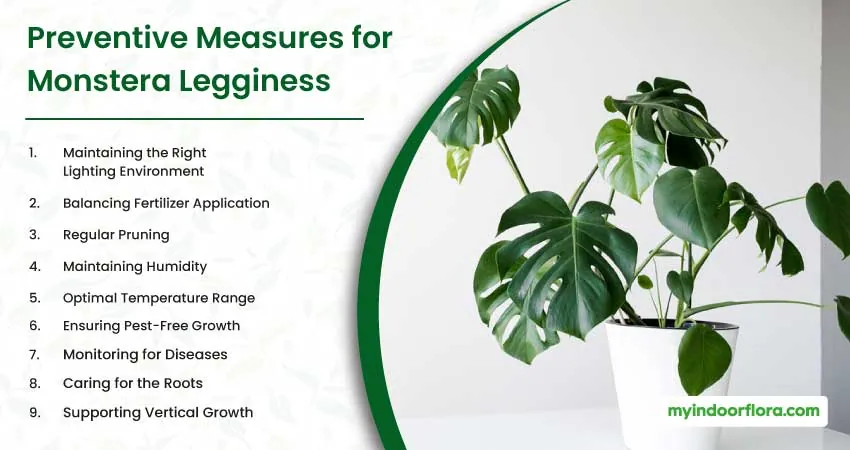The Monstera deliciosa, often referred to as the Swiss cheese plant due to its iconic split leaves, has grown in popularity as a beloved houseplant across the globe. Native to the tropical rainforests of Central America, this green gem has found its way into urban homes and spaces, celebrated both for its unique aesthetic and its adaptability to indoor environments.
A challenge, however, that many Monstera caretakers face is the issue of ‘legginess’. This term describes a growth pattern where the plant’s stems elongate significantly, with large gaps between leaves. Essentially, legginess is the Monstera’s way of telling you it’s striving to reach more light, pushing its growth in ways that might not be ideal for its health or appearance.
As you progress through this article, you’ll gain comprehensive insights into recognizing the signs of a leggy Monstera, discerning the causes, and mastering both remedial and preventive strategies. With this knowledge, your Monstera can thrive, reflecting the lush vibrancy it showcases in its natural habitat.
What does a Leggy Monstera Look Like?

Before diving into the solutions, it’s essential to understand the problem. Recognizing a leggy Monstera is the first step toward addressing the issue.
Monsteras, when healthy, exhibit a lush green color with well-spaced leaves. However, when they begin to stretch out, with gaps between foliage, it’s a sign that they’re becoming leggy. Not only will the stems appear thin and elongated, but you might also notice the leaves becoming smaller or even yellowing.
When trying to imagine a leggy Monstera, think of a tree in a dense forest, stretching its branches upwards, desperately seeking sunlight. The same principle applies to houseplants, including the Monstera.
Detailed Characteristics of a Leggy Monstera
- Spaced-out Leaves: This is a primary indicator. If your Monstera has leaves that are far apart as opposed to clustering close together, it’s becoming leggy. A well-grown Monstera should exhibit a dense pattern of leaves, giving it a full appearance. This spacing out is a direct response to inadequate light conditions. The plant is essentially trying to maximize its exposure to light by spacing out its leaves.
- Thin, Stretched Stems: Etiolation is the term used in botany to describe plants stretching towards a light source. When your Monstera doesn’t receive adequate light, it exhibits etiolation, growing taller with elongated stems. This stretching is a survival mechanism. In nature, plants that can’t access light won’t survive, so they grow in the direction of the most available light.
- Yellowing or Smaller Leaves: If the leaves at the base of your Monstera are turning yellow, while the ones at the top are smaller than usual, it’s a sign of a leggy plant. This happens because the plant is focusing its energy on growing upwards and not on the leaves’ breadth.
| Feature | Healthy Monstera | Leggy Monstera |
|---|---|---|
| Leaves | Dense, clustered | Spaced out |
| Stems | Robust, short | Thin, elongated |
| Color | Vibrant green | Pale, with some yellow leaves |
| Growth | Outwards, broad | Upwards, tall |
Reasons Why Monsteras Become Leggy

Plants, like any other living organisms, react to their environment. When conditions aren’t optimal, these reactions can manifest as unusual growth patterns, such as legginess in Monsteras.
1. Insufficient Light Exposure:
- Monsteras originate from the rainforests of Central America. Here, they’re accustomed to receiving filtered sunlight, shielded by the canopy above.
- When these conditions aren’t replicated at home, the plant will stretch out in search of more light. This behavior is a natural reaction, trying to mimic the filtered sunlight it would receive in its native habitat.
2. Overuse of Fertilizers:
- Plants require nutrients to grow. However, an excess of these nutrients can lead to rapid but weak growth.
- Over-fertilization can lead to a surge in certain nutrients, causing an imbalance. This imbalance can cause the plant to grow rapidly, resulting in leggy growth.
- It’s essential to use fertilizers judiciously, following the recommended amounts and ensuring they’re well-distributed within the soil.
3. Pests:
- Pests such as aphids and spider mites can weaken a Monstera. They suck the sap, which is essentially the lifeblood of the plant, leading to nutrient deprivation.
- As the plant gets weakened, its energy distribution gets affected. This diversion of energy can sometimes lead to legginess as the plant might prioritize certain growth patterns over others.
4. Extremes in Temperature:
- Monsteras are tropical plants. They thrive in consistent temperatures, typically between 65°F and 80°F.
- When exposed to temperatures outside this range, they experience stress. This stress can affect their growth, leading to unusual patterns, including legginess.
- It’s crucial to monitor the temperature of the room where the Monstera is placed, ensuring it stays within the optimal range.
5. Crowded Roots:
- Roots are the primary means for a plant to absorb nutrients. When they’re crowded or constricted, this absorption process gets hindered.
- A Monstera with crowded roots will not get the nutrients it needs, leading it to prioritize vertical growth in search of better conditions, resulting in legginess.
- Regularly checking the root health and ensuring the Monstera isn’t root-bound can help in preventing this issue.
How To Fix A Leggy Monstera: Immediate Solutions

A leggy Monstera might initially seem like a challenge, but with understanding and a few adjustments, your plant can return to its lush, vibrant state. Here’s a comprehensive guide to addressing legginess in Monsteras.
1. Pruning Techniques:
Pruning stands out as the most direct method to address the elongated growth of a Monstera. Undertaken ideally during its growth season, which spans the spring or early summer, pruning gives the Monstera an opportunity to recover and redirect its growth.
By using sterilized scissors or pruning shears, you can cut off the elongated stems just above a node. This action encourages the plant to sprout more branches from the node, leading to a denser growth pattern.
And remember, Monsteras are hardy. They can handle substantial pruning and will often bounce back even stronger with proper aftercare.
2. Optimizing Light Conditions:
The Monstera, native to the rainforests of Central America, has evolved under canopies that filter sunlight. If deprived of this in indoor conditions, the plant stretches, seeking more light. To mimic its natural habitat, ensure your Monstera is placed in bright, indirect sunlight.
East or north-facing windows are often ideal. For homes with limited natural light, grow lights, which replicate the sun’s spectrum, can be an invaluable tool. Periodic rotation ensures every part of the plant gets its share of light, preventing uneven growth.
3. Adjusting Fertilizer Application:
A balanced approach to fertilization can prevent rapid, weak growth in Monsteras. Using a balanced, water-soluble fertilizer with equal parts nitrogen, phosphorus, and potassium can cater to the overall needs of the plant.
Typically, a once-a-month fertilization during its growth season suffices. But, if you see signs like brown leaf tips or a white crust on the soil, consider cutting back. These are often indicators of over-fertilization.
4. Repotting for Healthier Growth:
Over time, a Monstera’s roots can outgrow their pot, leading to constrained growth. If you spot roots emerging from the pot’s drainage holes or if the plant seems oversized for its container, it’s repotting time.
Select a pot a couple of inches larger than the current one. Transplanting the Monstera and filling the pot with fresh soil can provide the roots with the space they need to flourish.
5. Pest Management:
Pests can be a silent bane for indoor plants, including Monsteras. Regular inspections, especially under the leaves, can help spot early infestations. While mild soap solutions can tackle minor outbreaks, natural solutions like neem oil can address more persistent pests without harming the plant.
6. Support for Vertical Growth:
In the wild, Monsteras are climbers. Providing them with a structure, like a moss pole, can encourage this natural behavior. As the Monstera grows, it can be gently tied to the pole, allowing it to grow upwards and maintain a healthy posture.
Preventive Measures for Monstera Legginess

The adage “prevention is better than cure” holds true, especially when it comes to maintaining the health and vitality of your Monstera. By understanding and implementing certain measures, you can ensure your Monstera grows robustly, without the unwanted elongated stems.
1. Maintaining the Right Lighting Environment:
One of the primary reasons Monsteras become leggy is due to insufficient light. These tropical plants, native to Central American rainforests, thrive under filtered sunlight. In your home, try to mimic this environment.
Place your Monstera in a spot where it receives bright, but indirect sunlight. East or north-facing windows often offer the best conditions.
If your living space lacks natural sunlight, consider investing in a grow light. These lights, designed specifically for plants, can offer the spectrum of light your Monstera needs to flourish without becoming leggy.
2. Balancing Fertilizer Application:
While fertilizers provide the essential nutrients for plants to grow, over-fertilization can lead to rapid, weak, and elongated growth. It’s crucial to strike a balance. Opt for a balanced fertilizer and adhere to the recommended frequency of application.
Typically, during the growing season, a once-a-month routine works best for Monsteras. And always keep an eye out for signs of over-fertilization, like salt crusts on the soil surface or the yellowing of leaf edges.
3. Regular Pruning:
Routine pruning can work wonders in maintaining the shape and health of your Monstera. By removing old or excessively long stems, you not only improve the plant’s appearance but also allow it to redirect its energy to newer growth.
This regular maintenance ensures that the plant doesn’t divert its energy to unwanted elongated growth. Remember to use sterilized shears or scissors to prevent any potential spread of diseases.
4. Maintaining Humidity:
Monsteras thrive in humid environments, replicating their natural rainforest habitat. In homes with dry air, consider using a humidifier or placing a tray with water near the plant.
Another effective method is misting the leaves regularly. This added moisture can deter spider mites, a common pest, and also promote healthier, more vibrant leaves.
5. Optimal Temperature Range:
Temperature plays a crucial role in the growth of Monsteras. They prefer a consistent temperature range, ideally between 65°F and 80°F. Sudden drops or spikes can stress the plant, leading to legginess.
Avoid placing your Monstera near radiators, air conditioners, or drafty windows. Monitoring the temperature and ensuring it stays within this range can lead to a more robust growth pattern.
6. Ensuring Pest-Free Growth:
Pests can indirectly contribute to legginess by weakening the plant. Regularly inspect your Monstera for common pests like aphids, spider mites, or mealybugs. Keeping your plant clean can deter many pests.
For those that still find their way to your Monstera, consider using natural remedies. Neem oil, for instance, acts as a fantastic deterrent, keeping pests at bay without introducing harmful chemicals to your plant.
7. Monitoring for Diseases:
Diseases can stress a plant, causing it to grow abnormally. Regularly inspect your Monstera for signs of disease. Yellowing leaves, brown spots, or wilting can all be indicative of underlying issues. Addressing these promptly can prevent the plant from becoming leggy due to stress.
8. Caring for the Roots:
The roots are the lifeline of your Monstera. A plant with cramped or rotting roots will not grow optimally. Ensure the pot has good drainage to prevent waterlogging. Every year or so, inspect the roots. If they seem too bunched up or come out of the drainage holes, it might be time to repot your Monstera, giving its roots the space they need.
9. Supporting Vertical Growth:
Monsteras, in their natural habitat, are climbers. Their tendency is to grow upwards, seeking support from nearby structures.
Staking: One of the simplest ways to provide this support is by staking. Using a sturdy stake, you can gently tie the Monstera’s stem to it, offering the plant the support it needs to grow vertically. As the plant grows taller, additional ties can be added, ensuring the Monstera remains upright. Staking not only promotes healthy vertical growth but also prevents the stems from becoming too elongated or leggy due to a lack of support.
Moss Poles: Beyond staking, moss poles serve as an excellent tool for Monsteras. These poles, covered in moss, replicate the trees Monsteras would climb in the wild. As the plant grows, its aerial roots latch onto the moss, providing natural support. This mimics the Monstera’s natural growth pattern, promoting healthier and more controlled growth.
Conclusion
A leggy Monstera might seem like a challenge, but with the right knowledge and care, it can thrive. Remember, plants communicate in their way. By understanding their needs and providing for them, you’ll be rewarded with a lush, green companion. Happy planting!
